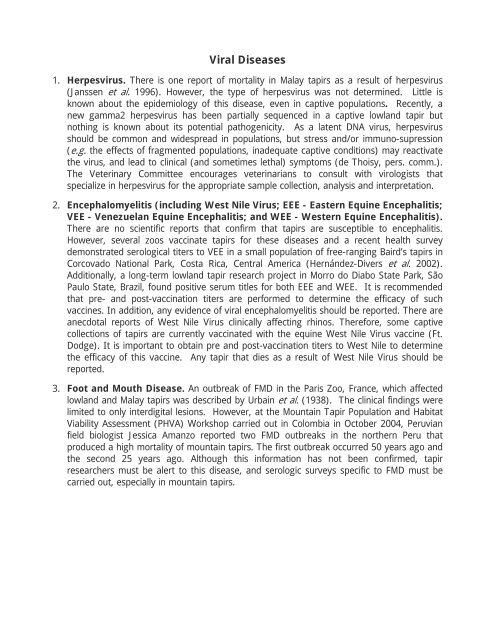TAPIR FIELD VETERINARY MANUAL - Tapir Specialist Group
TAPIR FIELD VETERINARY MANUAL - Tapir Specialist Group
TAPIR FIELD VETERINARY MANUAL - Tapir Specialist Group
You also want an ePaper? Increase the reach of your titles
YUMPU automatically turns print PDFs into web optimized ePapers that Google loves.
Viral Diseases<br />
1. Herpesvirus. There is one report of mortality in Malay tapirs as a result of herpesvirus<br />
(Janssen et al. 1996). However, the type of herpesvirus was not determined. Little is<br />
known about the epidemiology of this disease, even in captive populations. Recently, a<br />
new gamma2 herpesvirus has been partially sequenced in a captive lowland tapir but<br />
nothing is known about its potential pathogenicity. As a latent DNA virus, herpesvirus<br />
should be common and widespread in populations, but stress and/or immuno-supression<br />
(e.g. the effects of fragmented populations, inadequate captive conditions) may reactivate<br />
the virus, and lead to clinical (and sometimes lethal) symptoms (de Thoisy, pers. comm.).<br />
The Veterinary Committee encourages veterinarians to consult with virologists that<br />
specialize in herpesvirus for the appropriate sample collection, analysis and interpretation.<br />
2. Encephalomyelitis (including West Nile Virus; EEE - Eastern Equine Encephalitis;<br />
VEE - Venezuelan Equine Encephalitis; and WEE - Western Equine Encephalitis).<br />
There are no scientific reports that confirm that tapirs are susceptible to encephalitis.<br />
However, several zoos vaccinate tapirs for these diseases and a recent health survey<br />
demonstrated serological titers to VEE in a small population of free-ranging Baird’s tapirs in<br />
Corcovado National Park, Costa Rica, Central America (Hernández-Divers et al. 2002).<br />
Additionally, a long-term lowland tapir research project in Morro do Diabo State Park, São<br />
Paulo State, Brazil, found positive serum titles for both EEE and WEE. It is recommended<br />
that pre- and post-vaccination titers are performed to determine the efficacy of such<br />
vaccines. In addition, any evidence of viral encephalomyelitis should be reported. There are<br />
anecdotal reports of West Nile Virus clinically affecting rhinos. Therefore, some captive<br />
collections of tapirs are currently vaccinated with the equine West Nile Virus vaccine (Ft.<br />
Dodge). It is important to obtain pre and post-vaccination titers to West Nile to determine<br />
the efficacy of this vaccine. Any tapir that dies as a result of West Nile Virus should be<br />
reported.<br />
3. Foot and Mouth Disease. An outbreak of FMD in the Paris Zoo, France, which affected<br />
lowland and Malay tapirs was described by Urbain et al. (1938). The clinical findings were<br />
limited to only interdigital lesions. However, at the Mountain <strong>Tapir</strong> Population and Habitat<br />
Viability Assessment (PHVA) Workshop carried out in Colombia in October 2004, Peruvian<br />
field biologist Jessica Amanzo reported two FMD outbreaks in the northern Peru that<br />
produced a high mortality of mountain tapirs. The first outbreak occurred 50 years ago and<br />
the second 25 years ago. Although this information has not been confirmed, tapir<br />
researchers must be alert to this disease, and serologic surveys specific to FMD must be<br />
carried out, especially in mountain tapirs.










